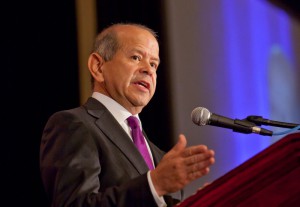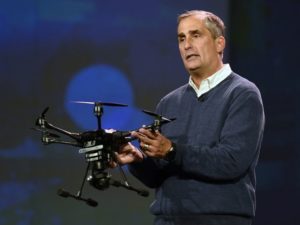 Outgoing FAA Administrator Michael Huerta and Intel‘s Brian Krzanich,the chair of the FAA’s Drone Advisory Committee, gave the keynote address to a packed house this morning at InterDrone.
Outgoing FAA Administrator Michael Huerta and Intel‘s Brian Krzanich,the chair of the FAA’s Drone Advisory Committee, gave the keynote address to a packed house this morning at InterDrone.
Huerta was greeted by enthusiastic applause, evidence of the success of his repeated efforts to form a collaborative relationship with the drone industry on regulations. Huerta said that drones are the “fastest growing” part of the aerospace industry – and a transformative technology.
Huerta began his speech by commenting on the drone repsonse to Hurricane Harvey. The FAA granted hundreds of authorizations for drone operators to fly over the affected area, allowing energy and transportation infrastructure inspections; search and rescue; and home insurance evaluations.
“In many of these situations, low level unmanned aircraft were able to perform these operations mor quickly and more safely than manned aircraft,” said Huerta. “… Every drone that flew meant that a traditional aircraft did not put additional strain on an already fragile infrastructure.”
Huerta then addressed the topic of drone integration, calling it a “massive and endless to-do list,” that “belongs to all of the stakeholders in the unmanned industry.” As he often has, he stressed the continued need for collaboration with the industry. Huerta said that the success so far of drone regulations was due to industry involvement. “If we had tried to go it alone, drone integration would have been a massive failure,” said Huerta.
“The difference between varying interests brings us all to the middle,” said Huerta.
The administrator then spoke about what has been a touchy subject in the drone industry – the proliferation of state and local drone laws. Huerta seemed to back down from the issue of preemption, which means that the FAA has sole jurisdiction over the Nationa Airspace (NAS.) Instead, Huerta said that the FAA and the Drone Advisory Committee were working on establishing the appropriate role for local governments in drone regulation. “Successfully blending unmanned aircraft into the airspace,” said Huerta, “will require input from state, local and tribal governments.”
About flying safely, Huerta asked the drone industry for cooperation in developing technologies that would work with regulations. “The solution isn’t you, and it isn’t me… it’s all of us,” he said.

Brian Krzanich focused on Intel’s specialty: data. “Data is the new oil,” said Krzanich, saying that in past times, oil and the combustion engine dramatically changed almost every industry. Now, said Krzanich: “Almost every industry you can think about…is being transformed by data.” Artificial Intelligence, he comments, is the combustion engine – making data an incredibly valuable commodity.
“When you bring the drone together with big data and insights… the whole world will begin to change,” said Krzanich, demonstrating the point with a video featuring Intel’s commercial drone as a data collection tool. “The future of drones is more about what you can do with that data… than the actual flight itself,” said Krzanich. “That’s a shift we all need to be thinking about: it’s the data.”
 An Intel pilot flew the Intel Falcon 8 with RealSense technology for the crowd. In a stunning demonstration of obstacle avoidance, the pilot flew an inspection application in a simulated building facade. Despite no GPS and an awkward angle from the stage, the drone stayed the exact distance to the wall regardless of how the drone was oriented – because the drone intelligence system remembers obstacles and avoids them. Even when the pilot steered towards obstacles, the drone easily adjusted the flight path to avoid them.
An Intel pilot flew the Intel Falcon 8 with RealSense technology for the crowd. In a stunning demonstration of obstacle avoidance, the pilot flew an inspection application in a simulated building facade. Despite no GPS and an awkward angle from the stage, the drone stayed the exact distance to the wall regardless of how the drone was oriented – because the drone intelligence system remembers obstacles and avoids them. Even when the pilot steered towards obstacles, the drone easily adjusted the flight path to avoid them.
But Intel’s real reveal was still to come. Intel is focused heavily on the development of their AI technologies. Next they demonstrated their command system; totally automated flight. With one touch of a button on his laptop, Krzanich launched the same drone to perform the full inspection mission – without a pilot. The data collection, geo-tagging and uploading for analysis is automated.
“The next step… is that the system does all of the analysis for you,” said Krzanich as he introduced the Intel Insight platform – an AI platform developed with leading commercial drone provider Delair-Tech. One of Intel’s experts then demonstrated the platform live, showing how the system was able to automatically detect and identify changes between images for an inspection application.
The demonstration of Intel’s AI technology was impressive – and shows that the company continues to take a leading role in shaping the development of the industry. “We’re exploring incredible ways for this technology to really impact people in a positive way,” said Krzanich.
From commercial and industrial uses to entertainment and drones for good, both speakers emphasized that uses for drone technology are changing and expanding rapidly. “If people can dream up a new use for drones,” said Huerta, “they’re making it a reality.”
“This is a great industry.”

Miriam McNabb is the Editor-in-Chief of DRONELIFE and CEO of JobForDrones, a professional drone services marketplace, and a fascinated observer of the emerging drone industry and the regulatory environment for drones. Miriam has penned over 3,000 articles focused on the commercial drone space and is an international speaker and recognized figure in the industry. Miriam has a degree from the University of Chicago and over 20 years of experience in high tech sales and marketing for new technologies.
For drone industry consulting or writing, Email Miriam.
TWITTER:@spaldingbarker
Subscribe to DroneLife here.







[…] FAA’s Huerta and Intel’s Krzanich: Drone Integration and Drone Data […]